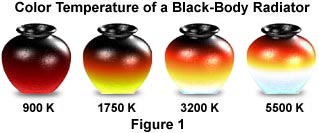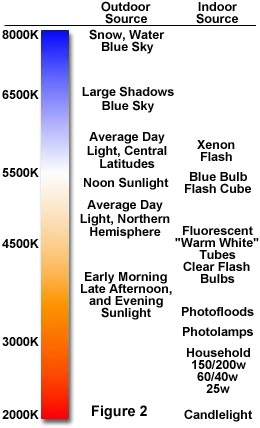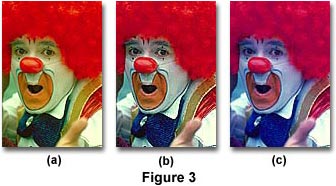The color temperature model is based on the relationship between the temperature of a theoretical standardized material, called a black body radiator, and the energy distribution of its emitted light as the radiator is brought to increasingly higher temperatures, measured in Kelvin (K). Although this radiator does not exist, many metals behave very similar to a black body so we can take a metal pot as an example for this discussion.

In our example, illustrated in Figure 1 above, the metal pot is first heated to a temperature of about 900 K (pot on the left), where it begins to glow a dull red. As the temperature is increased to between 1500 and 2000 K, the pot (second to the left) turns a yellowish to brighter red color. As the temperature is further increased above 3000 K the color turns to a yellow-white (the third pot from the left), and at 5000 K and above (the pot on the far right), a bluish-white color appears. The figure above can be further investigated in our interactive Java-powered Color Temperature Tutorial.
Color Temperature
Explore how color temperature is affected by changes in the temperature of a black body radiator.
The absolute temperature of the black body radiator is expressed in degrees Kelvin, which is equivalent to degrees Centigrade (° C) plus 273 degrees. For example, 1000 K equals 727 ° C. Therefore, we can define the color temperature of a light source as the value of the absolute temperature of a black body radiator when the radiator chromaticity matches that of the light source. In the case of fluorescent lamps that can only approximate the chromaticity of a black body, the corrected term "correlated" color temperature is applied through a calculated chromaticity.
The color temperature chart below (Figure 2) illustrates the range of colors generated by both inside (artificial) and outside (natural sunlight) lighting. Values falling below 3500 K are generally considered to be in the "tungsten" range and neutral colors viewed under this illumination often appear more red that they do under natural daylight.

The concept of color temperature is very important in the photography arena, where film emulsions must be balanced to accurately render color using different light sources. For instance, films intended to be used outside in ordinary daylight, fluorescent, and flash lighting are balanced during manufacture for a color temperature of 5500 K while films made for indoor tungsten light bulb use are balanced for a color temperature of 3200 to 3400 K. The 5500 K average daylight color spectrum varies during different parts of the day. In the early morning and late evening, the color temperature will fall to 5000 K and lower causing color shifts in the emulsion resulting in warmer (redder) color rendering.
Most light bulbs that are used for indoor illumination have some form of tungsten filament (with the exception of fluorescent bulbs). These bulbs emit a wavelength spectrum centered in the 3200 K color temperature region and films color balanced for this type of illumination will produce the best results. Using daylight balanced films under tungsten illumination will shift all color tones towards a decidedly yellow cast. Likewise, using tungsten balanced films under daylight illumination will shift color tones towards a bluer cast. All major film manufacturers have one or several 3200 K films available in 35 mm transparency format. Transparency film is preferable to color negative film for several reasons. First, all color negative films are color balanced for 5500 K and must be manipulated during printing to avoid the yellow cast mentioned above. Most photo processors can not or will not produce satisfactory results with photomicrographs on color negative film. Also, the contrast and color saturation in transparency film cannot be equaled by color negative film.

The clown photographs in Figure 3 above illustrate the proper use of color balance between film emulsions and illumination sources. The clown in the center (Figure 3(b)) was photographed under natural sunlight using daylight-balanced (5000 K) Fujichrome Velvia. Using the same film, the clown on the left (Figure 3(a)) was photographed indoors under tungsten illumination. Note that all hues are shifted to lower wavelengths and the overall image has a definite yellow cast. The clown on the right (Figure 3(c)) was photographed under natural sunlight, but this time the film was tungsten-balanced (3200 K) Fujichrome 64T. Under these conditions, the image has an overall blue cast and appears very unnatural. By carefully coordinating lighting conditions with film emulsion, most photographers can easily take beautiful images that accurately reproduce the actual colors of the subject.
Color Temperature - For a more detailed treatment of color temperature visit the corresponding article in our section on photomicrography.